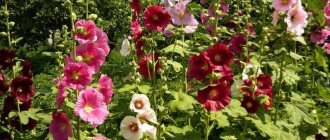Growing mallow from seeds is the most common way to propagate these flowers at home. The plant has another name - stockrose. Growing annual and perennial plant species is almost the same. The culture is valued for its beautiful buds, color and size, which depend on the type and variety. Decorative bushes can decorate any area.
Briefly about the history of the flower
Humanity has been familiar with mallow for at least 5,000 years. The Bible mentions that Moses prepared a medicine from mallow to help with fever. In the history of Ancient Egypt, this plant is also mentioned as a remedy. Japan considers mallow a patron who protects against natural disasters; in Ancient Rome it served as a universal antidote, in Europe it was used as a bride's assistant, and in Arab countries it is eaten. There are beliefs, legends and fairy tales associated with mallow. This flower can often be seen in book illustrations.
Terry mallow
Mallow flowers (or rather, the juice of the plant in the form of mucus) have a number of medicinal and strengthening properties, are used in folk medicine, but also have contraindications.
Where can you plant mallow?
In our gardens, mallow is an indispensable tall flowering plant in the background.
It looks great along walls and as a decoration for hedges. Mallow near houses Mallow has become very popular as cut flowers and in mixborders in combination with shorter and completely dwarf plants. And in compositions with cosmos and decorative sunflowers it can not only break up the space, but also create a tall “jungle” with a minimum of care. Many people use stockrose in combination with phlox, but for me this composition is too aggressive.
General features of terry mallow
Lobelia planting and care in the garden
Recently, this plant has begun to gain popularity again. One of the popular species among gardeners is terry mallow. This variety is a hybrid plant, bred by crossing rugose mallow and stockrose. Its characteristics:
- It has a lush multi-layered inflorescence, similar to smaller peony flowers.
- Each petal has a wavy edge.
- The stems reach a height of two meters, of which 75-80 cm is occupied by the peduncle.
- The variety is long-lasting and pleases with abundant flowering from June to mid-autumn.
- The color range of the buds varies from soft pink and peach tones to dark burgundy.
- The flower lasts a long time in a bouquet in a vase.
- Flowering begins from the bottom of the peduncle and gradually moves upward.
- Annual mallow or varieties of perennial crops are grown in garden plots.
Note! Terry mallow is a heat-loving plant, therefore it is often grown as an annual, since it does not tolerate harsh winters.
What does botanical science say about this?
It so happened historically that in botany there is no absolutely harmonious, indisputable system of classification (in other words, taxonomy) of plants, however, in order not to create unnecessary entities, botanists agreed among themselves on the International Code of Botanical Nomenclature. A typical taxonomic series “from the oldest unit to the youngest” looks like this: domain, kingdom, department, class, order, family, genus and species (possible additional and completely optional variations such as “superclass/subclass”, “superorder/suborder”, etc. .p. will be omitted for simplicity).
This hierarchy reflects the deep commonality of plants and animals: the domain “eukaryotes” indicates that we are talking about living creatures with a cellular structure, in which the cell nucleus is clearly distinguished, and the taxon “kingdom” with the meaning of “plants” clearly indicates that what we are talking about hereinafter is precisely about plants, not animals - etc. In relation to the case of interest to us, the series will look like this: domain - eukaryotes, kingdom - plants, division - flowering plants, class - dicotyledons, order - malvaceae, family - malvaceae, genus - stockrose (the specific name of the species is omitted). Judging by the names of the last three taxa, it already becomes clear that “in everyday life” confusion cannot be avoided if you do not explicitly indicate whether we are talking about a genus, family, or even the name of a species.
Favorite varieties of gardeners
Nemesia - planting and care in the garden
Only wild mallow grows in nature; all other types of mallow are grown specially. Today, many seeds are sold for growing both common mallow and new, selective varieties and colors of annual and perennial mallow.
There are more than 30 varieties of mallow. Each has its own characteristics. Knowing their descriptions, the gardener can easily choose the right plant for himself.
Chater's Strein variety
The variety has double flowers up to 15 cm in diameter; the flowers are very similar to peonies. The height of an adult stem reaches 2 meters.
Mallow Chaters Strain
Pinafore Mixed variety
This culture has glossy, double or simple flowers, many colors, but no scent. The stem of the plant reaches a height of 1 meter.
Pinafore mixed
Variety Majorette Mixed
One of the popular varieties. The flowers are semi-double, large, stem height is up to 75 cm. Majorette has all the primary colors of mallows.
Majorette mixed
Queeny Purple variety
A hybrid created by crossing marshmallow and pink mallow. It has an average height of 75 cm.
Queenie purple
Variety Creme de Cassis (Creme de Cassis)
This mallow is perennial, but is more often grown as a biennial. The height of the bush is from 1.5-2 meters in height. The culture is unusual - it can have simultaneously single-flowered, two-flowered, semi-double and double inflorescences with a diameter of up to 12 cm on one peduncle. The coloring is also ambiguous - it is white at the edges, and varies from red to dark brown towards the middle of the bud. Grows well in partial shade and sun.
Creme de casis
Variety Peach'n'dreams (Peach and Dreams)
Flowering of this variety begins in June and continues until autumn. The diameter of the buds is 10 cm. Their color is peach or pinkish. The buds consist of corrugated-wavy dense petals; in general, the flowers resemble a pom-pom or peony. The plant is perennial.
Peach and Dreams
Features of growing a plant
It is important to know that mallow seedlings are very fragile and can be easily damaged at the time of transplantation. To avoid this, you need to buy single-place peat pots that are buried in the soil along with the seedling
When to plant
Planting seeds should begin in April-May. If you have a greenhouse, the deadline can be shifted by a month. If seeds are directly sown in open ground, then you should stick to the time when the ground has completely warmed up and severe night frosts have passed. The end of May is the best option.
How to prepare seeds
Growing from mallow seeds ensures early flowering and maximum germination. The best seeds are those collected from a two-year-old plant or purchased in a store. The preparatory stage consists of soaking the seeds.
To do this, they are poured into a small bowl and filled with warm water. Leave in this state for 12 hours. During this time, the achenes take on water and then quickly hatch.
How to sow seeds
The sowing algorithm is as follows:
- Take separate pots or glasses, preferably peat ones. Pour soil into them; the most nutritious soil mixture, which includes peat, sand, soil, and sawdust, is suitable.
- Place one seed in each cup. If containers or seedling boxes are taken for planting, then furrows are made into which the seeds are placed at a distance of 1-2 cm. Sprinkle a 1 cm thick layer of the remaining mixture on top.
- Spill thoroughly and cover with a dark film or plastic cap.
- Place in a warm place, but the temperature under the shelter should not exceed 20 degrees.
After about 14 days, shoots will appear, which need to be pulled through so that the plants are stronger and stronger. To do this, pull out weak sprouts, leaving a distance of 3 cm between adjacent ones.
After the emergence of shoots, you cannot remove the film immediately. This is done gradually, first for 10 minutes and so on until the plants get used to daylight.
During growth, seedlings should be regularly watered, hardened and ventilated. With the appearance of the third leaf, it is customary to place the seedlings in a cool place. If the sprouts begin to stretch, provide additional lighting. The next stage of growing seedlings is transplanting into open ground.
Important! Mallow does not like picks, so it should only be planted with an earthen clod
Transplanting seedlings into open ground
In May they begin to plant plants in the flowerbed. The location of its growth is determined in advance, since it will not be possible to replant it later:
Choose a place that is bright and protected from strong winds. Due to the decent height of the plant, wind can negatively affect the beauty. The mallow will break off and bend. The hollyhock does not tolerate shady places. Her growth will be inhibited and her flowers will turn pale. The soil must be provided with humus and sand with large pebbles for drainage. In addition, lime should be added to the soil to reduce acidity, compost and sawdust
It is important to remember that the flower does not tolerate heavy clay soils. The holes are being prepared. Their location depends on the space occupied in the flowerbed, but it is worth maintaining a distance between neighbors of 30 to 60 cm. If the seedlings grow in peat pots, they are simply buried in the garden bed along with the container
If the container or pot is plastic, then you should transfer the seedling along with the soil into the hole and dig it in. Water the seedlings generously.
Mostly, seedlings are planted in the background of flower beds due to their height. The first plan is not suitable for mallow, as it will block other flowers.
Other common varieties
Eschscholzia flowers - planting and care in the garden
Almost everyone knows what a mallow flower looks like. When its name is mentioned, one imagines a tall, human-sized plant, densely strewn with flowers and found absolutely everywhere. A flower from childhood. Children love to make earrings and tufts from mallow petals; they stick easily to the skin, since the juice of the mallow flower is sticky.
On a note! Some species are found everywhere, but not everyone knows what their differences and features are.
Musk mallow
This variety is low - from 20 cm to 1 meter. Has a musky aroma. The stems are straight, rough, densely covered with hairs. The diameter of the flowers is up to 5 cm, the color is white or pink. The culture requires good lighting of the site and does not like wind. Grows on soft soils. The most popular varieties of musky mallow are Pink Tower, White Tower, White Perfection.
Malva woodland
It grows in the wild in forests and park areas in North-West India, Central and Asia Minor, northern Africa and Europe. But gardeners also grow it on plots.
Forest mallow is squat, with a height of 30 to 120 cm. The plant is biennial. Stems are smooth and straight. Famous varieties are the dark purple Black Pearl and the light pink Zebrina. There is also a variety of woodland mallow, Blue Fontaine, which grows up to 70 cm, and its flowers are purple with a blue border.
Mallow wrinkled
This is a perennial bush mallow, not classified according to special indicators, it is not customary to classify it as a separate species. But many flower growers are sure that this plant is not related to the mallow family.
Sudanese mallow
A wild plant found in Turkey and Greece, it is cultivated for its fruit. This variety has a second name - Hibiscus Sabdariffa. The plant has 3-5 stems up to 2 meters high. The color of the buds is black and red.
On a note! This biennial plant blooms from June to late autumn.
Mallow pink
The bud color of this light mallow is creamy pink. They are densely collected in inflorescences. The height of the stems is 2 meters. Grows well in moist and sunny places. The perennial blooms in the second year after planting.
Hybrid mallow
The plant has several stems and reaches a height of 2 meters. The variety blooms from June to September.
Description and features of mallow
The plants have erect, powerful stems on which there are rounded leaves, the edges of which have grooves. The lower leaf blades are much larger than those located at the top. About 15 shoots are formed on each bush.
The height of mallow, which is planted as seedlings, varies depending on the type and variety. It ranges from 80 cm to 2 m.
The flowers are located in the axils of the leaf blades and are fused at the base. The top of the bud is split. The diameter of the flowers is 5-15 cm.
There are different types of mallow, the cultivation of which interests gardeners. As for varieties, breeders have tried to create a huge variety. The buds differ not only in size, but also in color palette. Eat:
- white and pink;
- red and burgundy;
- black and striped.
In addition, the buds are simple, semi-double and double. So there is plenty to choose from.
Types of mallow
The main types of mallow grown by Russian flower growers.
- Annual. Height - about 130 cm. Flowers are simple, pale pink.
- Hybrid mallow or wild mallow. The main method of cultivation is by seeds in an annual or biennial crop. The plant is tall (up to 2 m), with abundant flowering throughout the growing season. The buds, depending on the variety, are pink, red, white.
- Musk mallow. It is a perennial crop; the main method of cultivation is by seeds. The flowers are white or pink, almost 6 cm in diameter.
- Mallow whorled. It grows wild in Siberia. The annual plant grows up to 2 m. The buds are white or pink.
- Rose-stock. Growing in annual, biennial and perennial crops. Mallow is very tall, with proper agricultural technology it reaches 250 cm. The color palette of the buds is very diverse; they can be represented by double flowers of different shades:
- white and yellow;
- red and pink;
- purple-lilac and inky.
Growing stockrose has recently become fashionable. Moreover, the variety of varieties allows you to make a choice.
Methods for propagating terry mallow
Growing terry mallow from seeds is possible in two ways: by planting seeds in open ground or sowing seedlings. It seems that mallow is able to germinate from seeds in any case, but this is not the case. Experienced gardeners prefer the second method to the first, as they consider it more reliable for obtaining healthy plants. With this method, the plant begins to bloom in the first year, manages to get stronger during the summer season, the buds are larger, and the flowering is abundant.
Note! In open ground, germination is uneven and takes longer. The plant will need more time to root and form a crown. In addition, in this case, the mallow will not bloom in the first year.
Time to board
Seeds are sown in open ground in mid-May. To obtain seedlings, you need to plant them in March, then by May the sprouts will have become stronger and can be transplanted to the site.
Selection of capacity
For planting seedlings, it is best to purchase peat pots. When using them, the seeds germinate better, and when moved into the soil, the sprouts can be planted directly in the pot - it will dissolve and become an additional fertilizer. You can plant the plant in plastic and paper cups. But when planting in the ground, they must be removed, leaving the plant itself with the ground.
Terry mallow seedlings
Preparing soil and seed
It is better to immediately choose a permanent place. Terry mallow loves sunlight and does not tolerate drafts. It is able to grow in different soils, its root is quite long, penetrates deeply into the ground and receives all the necessary minerals. The best option for the crop would be loamy soil with a high humus content. But if the soil is very clayey, then it can be mixed with peat, sand and humus.
Mallow seeds from last year's harvest are more difficult to germinate than 1.5-2 year old ones.
On a note! Before planting seeds, you can soak them in warm water overnight or for a day so that the protective film swells, and then sow.
Seedling care
Seedlings germinate at a temperature of at least +20 degrees after 2 weeks, after which it is necessary to identify damaged and weak sprouts and remove them. There is no need to feed them; watering as the soil dries out is sufficient. You need to germinate seedlings under a film and open it 1-2 times every 5-6 days for 3 hours.
Dive and transfer
Seedlings should be replanted according to the principle - tall varieties at a distance of 70 cm from each other, low-growing ones - 50 cm. The holes should be made 3-5 cm deep.
Planting cuttings
Cuttings must be cut from the base of an adult stem. Sprinkle the cut areas with crushed charcoal. Plant them in a flower pot for rooting under film. After rooting, they should be planted on the site, maintaining a distance.
Important! It should be taken into account that not all cuttings will be accepted, so it is better to plant with a reserve.
When to sow mallow for seedlings in 2022 according to the Lunar calendar?
The right thing is done by flower growers who, when growing at home, check the timing of sowing crops with the dates indicated in the Lunar calendar. The energy of suitable/unsuitable days affects the germination and development of stock rose seedlings.
Favorable days for sowing mallow in 2022 (by month)
| In January | In February | In March | In April | In May | In June | |
| Preparation/Soaking | 21, 22, 26, 27 | from 12 to 14, 17-24 | 12-14,17, 18, 23-24 | 18-19, 26-28 | 20, 22, 24, 25 | 21, 22, 23, 29-30 |
| Sowing | 3-9, 16-17, 20-23, 25-27, 30-31 | 4, 7-9, 12-14, 7-25 | 3, 5, 8, 14-22, 24-27 | 3, 5, 8-9, 13, 15-22, 24-26 | 2, 5-7, 12-17, 19-22, 24, 25, 28 and 29 | 2, 3, 6-8, 15-26, 29, 30 |
| Picking / Transplanting | 5-9, 16-17, 21-23, 25-27 | 2-5, 7-9, 20-24 | 1, 3-5, 8, 15, 19 and 28 | 1, 3, 5, 8, 9, 13, 15-19, 28 | 1, 2, 5, 13, 15, 16,17, 20, 24, 28-29 | 2-3, 6-8, 11-13, 6, 21-23, 29-30 |
Bad days to plant mallow seeds in 2021
| In January | In February | In March | In April | In May | In June | |
| Do not carry out cultivation robots | 2, 3, 10, 13-15, 28 and 31 | 10, 11, 21, 22, 26 and 27 | 9-11, 13, 19-21, 25, 26, 28 | 3-4, 12, 15-17, 20-22, 27 and 30 | 3, 4, 8-9, 11, 24, 30 and 31 | 1, 4-5, 10, 14-15, 24, 27-28 |
Features of garden care
The shrub will not require special care. It is able to grow actively in any unfavorable conditions. But to get a truly healthy and elegant plant, it is better to familiarize yourself with some rules.
What conditions do hollyhocks like?
The culture grows and blooms both in well-lit places and in partial shade. But in shady areas it produces scanty flower stalks.
In windy areas, it is better to make dense plantings of mallow, so they will create a natural barrier from the wind. The stems of a single bush may not withstand gusts of wind and may break or bend towards the ground, that is, they will not be erect.
It is better to plant terry mallow not in the middle of the plot, but near a support (wall, fence, etc.). But if this is not possible, then you should think about a support for the bush.
Important! The main thing is that the supports for the mallow are not made of metal.
Watering
It is enough to water the crop once a week, but in dry weather watering should be more frequent.
Mulching and fertilizing
The plant must be fertilized the next year after planting. It is better to start fertilizing in June, you need to apply phosphorus-potassium products 1-2 times a week, and before the formation of a peduncle, water the plant with nitrogen fertilizers, but carefully. Fertilizing too much nitrogen can have the opposite effect. Mulching with peat and humus is important every year.
Loosening
Terry mallow needs to be loosened and weeded regularly to saturate the soil with oxygen and rid the plant of proximity to weeds. Loosening should be shallow so as not to damage the roots of the plant.
Transfer
If there is a need to move the plant to another place, you need to remember about possible damage to the roots when digging up the crop, so it is better to dig a layer of earth wider and deeper and move the flower along with a lump of earth.
On a note! It is better not to replant the bush unless absolutely necessary; there is a high probability that it will not take root in the new place.
How to determine the time of sowing mallow?
To grow annual stock roses, sowing is carried out from late February to mid-March. There is no need to be afraid of cold weather: mallow is not afraid of lower temperatures.
Biennial seeds are sown in the garden bed from April to the end of May. Pre-winter sowing is carried out in the fall, in October. To avoid seed death, sowing is carried out in October. With spring warming, seeds sown on the eve of winter germinate.
ATTENTION! The flowering of the rose stem depends on the timing of sowing. Bushes grown at home from seedlings will delight the eye already in September. Plants that were planted in the ground in May will produce flower stalks the following year.
All about the flowering of double mallow
The point of growing mallow is to obtain a lush flower arrangement. Particularly beautiful flower beds are obtained by combining varieties and colors. The buds of each variety are similar at first glance, but they still have individual features.
Types and forms of flowers
Double mallow flowers come in a wide range of colors (red, pink, lilac, purple, blue and yellow) and come in different shades from dark to light. There are also hybrid two-color varieties. The bud consists of many double petals united into one lush inflorescence resembling a pom-pom.
The stems are erect and thick, covered with hairs. The leaves of the mallow are wide and have a carved wavy edge, and their surface is rough.
Flowering and care features during this period
Terry varieties are characterized by low winter hardiness. They bloom profusely in July and August. It is recommended at this time to moderately water the plant with nitrogen fertilizers for active flowering.
After the flowering period, you need to remove dried buds or, after complete flowering, cut off the peduncle completely.
Note! You cannot cut the peduncle or pick off dry flowers if you plan to collect seeds.
Is it possible to grow strawberries at home in an apartment?
This is possible, and in this article I will share my experience of growing strawberries on a windowsill. By the way, instead of strawberries there can be strawberries.
1. Choose seeds suitable for growing on the balcony. This is usually indicated on the packaging. In my case, the choice fell on the Alexandrina variety.
I carefully study the packaging of strawberry seeds
2. I used universal primer.
I used the most common soil
3. Sow so that there is a distance of half a centimeter or more between the seeds.
I diligently sow in rows
4. This is what the seeds looked like after a month
They must be watered carefully, without flooding. Read about how to water correctly here -
first strawberry shoots
5. A month later. As usual, I missed the ideal condition for replanting - two real leaves.
strawberries have grown significantly
6. Transplant into a large container.
transplant process
transplanted strawberries into a large pot
7. After another 2 months (September 24, 2022), the first flowers appeared.
wow, what a big strawberry has become
8. I have already tried to grow this variety in a half-liter bottle. I collected 20 berries in total.
and here is my first experiment with strawberries
9. Strawberries taste sweet with a slight sourness. There are berries, both beautiful and regular in shape, and some not very well shaped. But both taste good.
strawberries taste sweet
A more detailed story about growing strawberries.
Possible problems in growing
All types of plants are susceptible to disease and have their fans among insects. When growing mallow, small and large problems also arise; each of them has its own techniques and means of protection in the form of drugs.
Pests and diseases
The most common disease is mallow “rust,” when some or all of the plant’s leaves become covered with red spots on the inside and dry out. Such parts must be removed in a timely manner to tidy up the appearance and so that the disease does not affect neighboring parts. Rust is a fungal disease and must be controlled with antifungals or garden fungicides. It is better to immediately treat young seedlings with one of the solutions of colloidal sulfur, Bordeaux mixture or copper oxychloride.
During dry periods, the crop may be attacked by caterpillars, thrips, aphids or spider mites. They suck out the sap of the plant, leaving behind dried and curled leaves and flowers. You need to pay attention to the back of the leaves - there may be clutches of insect eggs there.
At this time, you need to completely spray the plant with water to knock down insects, and treat it with special garden preparations.
Mallow rust disease
Signs of improper care
The main signs of an unhealthy plant or improper care for it are dry leaves and trunks and little flowering. If the gardener is concerned about the further viability of the crop, measures must be taken to restore it. Otherwise the plant will be lost.
Mallow care
Mallow, like any flowering plant, needs cosmetic care during the flowering period: removing faded peduncles or pruning to 30 cm, tying to plant pegs in windy weather: due to its high growth, the plant may break in strong winds.
- Watering - prefers moderate, does not like soil acidification.
- Fertilizing - if the soil is fertile, then fertilizing is not required. On poor soils, a week before flowering, you can fertilize with complex mineral fertilizer. Poor soil can be nourished by mulching it with compost.
- Shelter for the winter - stockrose can be covered with spruce branches or dry leaves.
- Diseases - highly susceptible to rust, it is recommended to spray a solution of colloidal sulfur or other preparations with a fungicidal effect on the leaves.
Use in landscape design
With the help of terry mallow you can achieve a wonderful look in the garden or park. It is better to plant it along fences or under a wall in a row as densely as possible in the form of a colored plant fence. In this case, you can combine varieties and colors. The beautiful dense inflorescences of mallow and its size and growth can disguise any unattractive areas of the garden, cover up the appearance of buildings or fences.
Annual low varieties look impressive in large pots, looking like lush bouquets.
Colored hollyhock fence
Many people consider the common mallow to be a weed and try to remove it from their garden. This is due to the fact that some varieties of the crop have high vitality, grow quickly, and are not so easy to say goodbye to. But it is worth paying attention to the fact that currently there are many varieties of plants that will become a worthy decoration of the garden and will help to remove all the unsightly corners of the site. Mallow will not go unnoticed; the gardener will have something to be proud of!
When to plant depending on the region?
Mallow is cultivated in Russia, Ukraine and Uzbekistan. As a medicinal, fodder and ornamental plant, mallow is grown in areas with warm and cold climates, as well as in the central zone.
Mid latitudes
In the middle zone, stock roses are planted in open ground in spring and autumn. To preserve flowers, they are covered in a greenhouse, placed in a cellar or in cold storage. These measures will help the mallow to safely survive the frosts.
Southern regions
Given the cold-resistant characteristics of the flower, during the winter months it is left to overwinter in the garden bed. In October-November, a mulch layer is laid at the base. This is enough for crops growing in warm areas.
North
Residents of the region have to give up growing mallow. In the harsh northern climate, it loses its winter hardiness. But some species adapt and grow in cold conditions with additional shelter and insulation. You can use spruce branches, spunbond, film or agrofibre. These measures will protect the mallow and help it survive the cold.
Disease Control
Among the diseases that most often affect perennial mallow are powdery mildew and leaf mosaic. It happens that its leaves are covered with brown spots of rust. When the first signs of the disease appear, all diseased parts of the plants should be removed and burned, and the bushes should be treated with Bordeaux mixture and appropriate preparations. To prevent diseases, you should not plant perennial mallow for 3-4 years in areas where crops that were susceptible to the same pathologies previously grew.
The consequence of waterlogging the soil under plants can be the appearance of slugs. Among other pests, mallow is most often affected by spider mites or aphids. Insecticidal or folk remedies can save you from them. For example, a soap solution of dry mustard effectively fights against aphids.
Place, planting time and care
The height of the stockrose can reach two or more meters. This advantage determines the place for planting mallow near a fence or wall. In other places, you will have to provide support for flower stalks.
The site for planting mallow must be chosen as sunny, with protection from winds and fertile soil.
The roots of the plant penetrate deep into the soil and can reach water at a depth of about a meter. Excessive moisture near the roots can be avoided by preparing the planting hole. Fine crushed stone, broken brick, then a layer of sand are poured onto its bottom as drainage. To improve poor soil when planting, prepare a mixture of rotted manure, garden soil and soil for seedlings in a 2:1:2 ratio. Fertilizer with microelements is added to the same mixture.
Caring for mallow is easy:
- Infrequent but abundant watering
- Removing old colors
- Treatment for diseases and insects
- Loosening and mulching the soil
- Feeding
It is recommended to water the holly once a week generously. Feeding must be done during the formation of buds. Once a month, a mixture of humus and mineral complex fertilizers is prepared and applied at the root, loosening the soil around the plant. After this, the plant must be well watered at the rate of 8 liters per adult bush.
In the first two years of life, perennial mallow needs to be covered before wintering.
In the first two years of life, perennial mallow needs to be covered before wintering. In October, the plant is pruned at a distance of 10-15 cm from the soil surface.
The best way to protect against frost and damping off is a dry shelter. To do this, an inverted wooden box filled with dry leaves and spruce paws is placed above the plant. To protect against diseases, the plant should be covered with marigolds picked for the winter.
By caring for and caring for a flower, the gardener knows that he will be grateful for the magnificent bloom.
What you need to plant mallow
First you need to determine exactly the timing and location. First things first. The time of planting is strongly influenced by the selected variety and planting method. The easiest one seems to be the seed one. However, such a plant will bloom only by the next season, at best. Sowing by seedlings helps reduce the time before flowering.
It is worth sowing in open ground in mid-June to eliminate the possibility of return frosts at night. For seedlings, it is worth choosing the end of winter with further picking into open soil at the very end of May.
Choosing the optimal location
In order for the cottage to turn into a real work of art, you need to choose the right place where to plant the plant. This is especially important when it comes to perennials. Good lighting is required. It is better to locate further from groundwater. The ideal place is elevated. You can create it artificially.
Important! The plant needs sunlight only in the morning and evening hours. The rest of the time, it is worth covering it from direct scorching rays so that the tender leaves of the young plant do not get burned.
The arrows of a young plant are fragile and can easily break in the wind. Therefore, it is worth planting the seedling in a place protected from light. For example, along the fence and make garters. The soil needs to be nutritious, airy, with good drainage. Water should not be allowed to stagnate in the soil. This can cause root rot disease.
Feeding mallow for lush flowering in summer
For abundant, decorative flowering, you need to care for the plant, in particular, apply fertilizer. Mallow loves organic things. Phosphorus and potassium must be added.
After applying fertilizer, you can cover the ground with mulch to retain nutrients in the soil for a longer time.
Preparing for winter
Care is also required in winter, when the plant is in a “dormant” state. An important procedure is to prune long branches immediately after flowering. You need to cut to the very root. This will help maintain its shape and reduce the occurrence of pests to a minimum. It is good to make a shelter for the mallow so that it is warm during the dormant period. You can cover it with spruce branches.
Mallow is an elegant plant, despite its size. Can decorate any planting site. Differs in flowering. First, the lower buds bloom and so on until the very top. It's interesting to watch this process. Many summer residents grow mallow. She is unpretentious and easy to care for.











